CTP Episode of the Day - 12.25.06 - How the Ghosts Stole Christmas
There's only one possible choice for today's Episode of the Day!
Today's Cherished Episode: How the Ghosts Stole Christmas (6x08)
Original Air Date: December 13, 1998
Written By: Chris Carter
Directed By: Chris Carter
On Christmas Eve, Mulder and Scully are trapped in a house haunted by its murder-filled history. They encounter the mansion's original owners -- and struggle to stay alive until midnight.

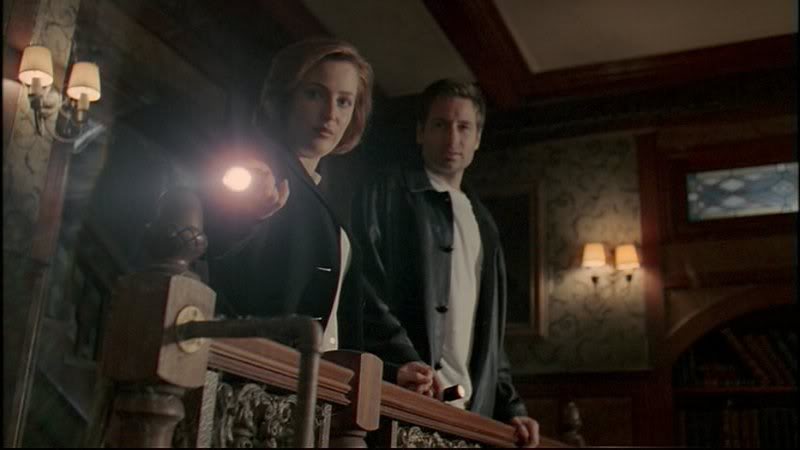
S: "Mulder, none of that really happened out there tonight. That was all in our heads, right?"
M: "I ... it must have been."
S: "Mmm. Not that my only joy in life is proving you wrong."
M: "When have you proved me wrong?"
S: "Well ... why else would you want me out there with you?"
M: "You didn't want to be there? Oh, that's um ... that's self-righteous and narcissistic of me to say, isn't it?"
S: "No, I mean ... maybe I did want to be out there with you."
Some "How the Ghosts Stole Christmas" Tidbits & Musings:
-- "How the Ghosts Stole Christmas," written and directed by Chris Carter, was a tense and twisted evocation of the holiday spirit; a masterwork of tight plotting; and a delightfully creepy look into the darker recesses of the Mulder-Scully relationship.
-- "We had been spending a lot of Fox's money in the sixth season," explained Carter. "We were learning how to do the show in L.A. and it was expensive and time-consuming. We kept promising we were going to do an episode that would save them a lot of money. We were going to do something that took place in one room. And these were always a challenge because you had to figure out how to tell an X-File, which usually had a lot of movement, a lot of procedural quality to it. You had to figure out how to stage a scary story in a confined space."
-- "It was the absolute record-holder for fewest dollars spent on a sixth season episode, and also one of the most difficult shows that we ever did," said Carter proudly. "We worked very hard on this one, especially toward the end of the shoot. The final day, as I remember, we filmed for 19 hours straight, from 3 p.m. on a Friday afternoon to 10 a.m. Saturday morning."
-- Added Carter, "It was based on an idea about a haunted house that Frank Spotnitz and I had been working on. Actually, the whole episode was about getting to the scene where David and Gillian drag themselves bloodily across the floor, and about keeping all of the action basically on one set and one location."
-- Amidst the episode's ambitious camera moves, interlocking plot lines, spooky atmospherics, and sophisticated dialogue, "HTGSC" was told in seamless form without several costly X-Files production staples: large numbers of stage sets and out-of-studio locations, for instance; or an extensive list of guest stars and supporting players.
-- Expenses for budget items like scouting, location rental, wardrobe, and transportation were kept to a bare minimum. Nor was the sound, special effects, or other postproduction tasks particularly complicated -- at least for The X-Files. Of course, there was a price to pay: economizing in this manner put even more of the burden on Carter, the four actors, and several other key staffers. For example:
-- "Right after the fourth show," recalled production designer Corey Kaplan, "I got a call from Frank and he asked me, 'Do you think we could shoot a whole episode on one stage?' And I answered, 'Well, why don't we do something like My Dinner With Andre, where the camera just stayed in one room and kept circling and circling the action?' And he said, 'Well, that's a good idea. I'll go tell Chris about that.'"
-- "And Frank called back a day later," Kaplan continued, "and said, 'Okay, we're going to do it. Chris is inspired. We'll just have the camera circle around one of the sets.' Then I said, pretty naively, I guess, 'Why don't we do it in Scully's apartment? It's one of our permanent sets and we haven't shot anything at all there this season.' And that's when he asked me: 'Do you think you could build a mansion?'"
-- Kaplan gulped, braced herself, and with a month or so head start, designed the most complicated and beautifully detailed stage set of the season. The richly decorated full-scale interior of a two-story Victorian house, complete with enough trap doors, secret passageways, hallways, and stairways, gave full reign to her boss's imagination.
-- "It had to be bleak, but not too bleak. Decrepit, but not too decrepit. Deserted, but not too deserted," said the designer, still turning the problem over in her mind months later.
-- Said construction supervisor Duke Tomasick, admiringly, "It was quality work. I don't think I had ever seen better. It was an honor to build it for her."
-- Added producer Paul Rabwin: "Corey Kaplan built this wonderful, wonderful set, in which they go from one room into another room and it's the same room, which was quite a challenge to pull off a room like that. It had bookshelves where the books would fly out. Trap doors. It was great fun. Ed Asner and Lily Tomlin really came to the plate on that."
-- Speaking of which, that was several notches above the ordinary, of course: the casting of Lily Tomlin and Edward Asner as the mansion's long-term tenants.
-- "The way all that started," said casting director Rick Millikan, "was that Lily Tomlin approached us a couple of seasons before. Her agent called, actually, and told me that Lily loved The X-Files and would love to come on the show someday. So I told Chris, and he had set up a meeting for Lily with him, and they got together and discussed some ideas for the future. Well, two years passed, and then suddenly Chris decided to write this episode for her. Originally, I think he had Bob Newhart in mind to play her husband. But Bob Newhart didn't want to do it."
-- Veteran actor Asner -- former star of The Mary Tyler Moore Show and Lou Grant -- proved both available in mid-October and capable of wrapping himself around Chris Carter's unusual vision of his character. "Obviously," said Millikan with a contented smile, "it all worked out very nicely."
-- But not until some other problems -- no more or less unsolvable than on any "normal" X-Files episode -- were solved. To create an "ethereal" look for Tomlin's character, makeup department head Cheri Montesanto-Medcalf gave her as radiant and non-threatening a complexion as possible, drawing attention to her eyes to produce a "dreamy" and "mesmerizing" effect. To make her a stylishly dressed Victorian ghost, costume designer Christine Peters rented an antique 1890's nightgown, then constructed several exact copies for Tomlin to wear during filming. ("I just didnt' see her flying around the mansion in bell bottoms and Maude hat," said Peters.)
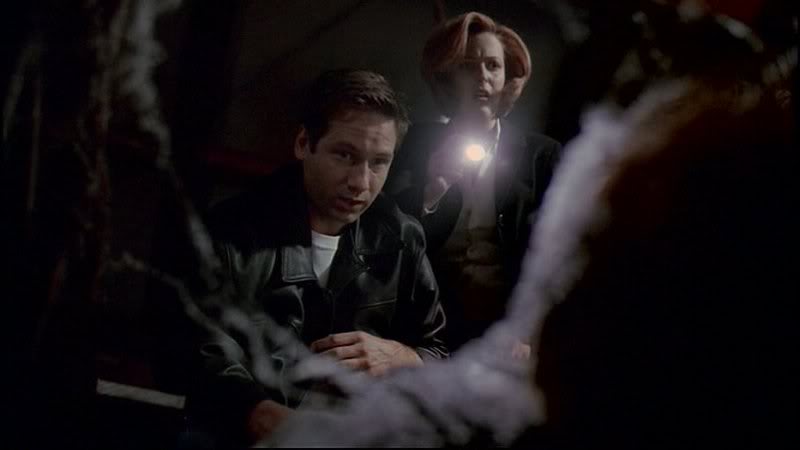

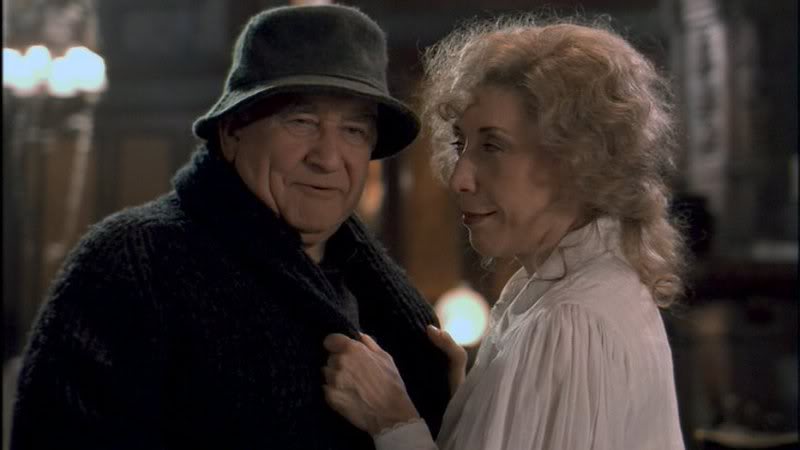
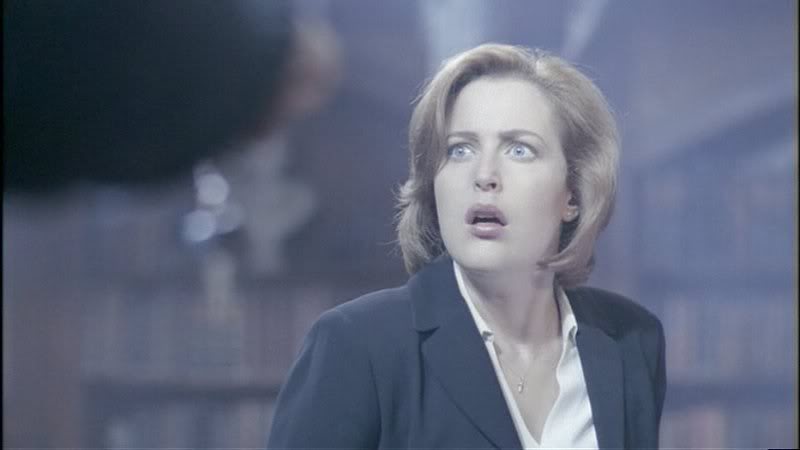
-- To craft the mummified remains of Mulder and Scully, special effects makeup supervisor John Vulich called his predecessor in Vancouver, Toby Lindala, to borrow silicon molds of two plaster skeletons of Mulder and Scully that were used in previous episodes. "Then," said Vulich, "we poured sculpting clay into the molds, and carved the mummified and emaciated features of the two agents. We were careful not to make the likenesses too recognizable -- Chris didn't want their identities apparent to the viewers until a long beat or two later."
-- "So we had to have that beat, that gap, dramatically," added Vulich, "which to me really worked well from a dramatic standpoint, but from a design standpoint it made it difficult for us to find that balance. For once you knew it was them, you'd recognize it, but if nobody told you, you wouldn't. So that was an example of how we were treading this fine balance design-wise to accommodate a story function."
-- To produce the interesting sight of large, round, bloodless bullet holes clear through Ed Asner's head and Lily Tomlin's stomach, special effects producer Bill Millar attached pieces of orange fluorescent cloth to the areas of the actors' bodies to be excised; added an ultraviolet light source to the set lighting; and used the invisibly reflected ultraviolet light as tracking data to place the computerized digital illusion on the actors' bodies in postproduction.
-- "It was the same thing they did previously on that movie Death Becomes Her," conceded Millar. "But we did it better and with less money."
-- And finally, to provide the one and only location in "HTGSC" -- the exterior of the haunted mansion -- locations manager Ilt Jones traveled back to Piru, the small town where much of "The Rain King" had been filmed. He rented the Piru Mansion: a circa 1890 Queen Anne-style residence built by an eccentric millionaire and used ainly for weddings, fund-raising events, and dozens of other TV and movie projects.
-- What could go wrong with such a simple and straightforward arrangement? "Nothing," said Jones. "Except that one Sunday afternoon I was home relaxing when I got a call from my assistant Francie Metz, who was prepping the mansion for the filming beginning the next day. She said, 'Ilt, I don't mean to alarm you or anything, but the whole hill behind the house is on fire.' I said 'What?'"
-- "It seems there was a big-time brush fire in the area," Jones said. "I jumped in my car and broke every speed record to get there. When I arrived, the ridges for five miles in each direction were blazing merrily. I'd never seen so many fire engines in my life. Seven or eight of those Super Scooper firefighting planes were bombing the area, and lots of water-dropping helicopters were buzzing overhead also."
-- "I thought, Oh, God! This is great. What am I gonna do? It looked like the fire would be on top of our mansion within minutes. So I sort of pathetically went over to some firemen who were just standing around -- smoking cigarettes, I might add -- and asked them what we could do to stave off this catastrophe and let me keep my job. They said, 'Don't worry about it. We've dug a fire break. It'll be cool.' And sure enough, about an hour later the whole thing fizzed out -- about 300 feet from the house."
-- Ilt (short of Illtyd) Jones is a native of Wales and a former semi-professional rugby player. Before becoming a location manager for TV shows and movies, he learned the geography of Los Angeles by operating a motorcycle messenger service.
-- The episode title is a play on the popular holiday tale, How the Grinch Stole Christmas.
-- "HTGSC" was the eighth episode of the season filmed, but was the sixth episode aired. It was moved up in order to air before the Christmas holiday. It was the last episode aired in 1998.
-- The haunted house's address, 1501 Larkspur Lane, may be a reference to a Nancy Drew mystery story, "Password to Larkspur Lane."
-- 1013 reference: As the episode opened, Mulder was listening to Christmas music on radio station 101.3.
-- Composer Mark Snow particularly enjoyed this episode and creating passages of Baroque-style harpsichord music. "I remember ripping off Haydn's 'Toy' Symphony for that," he said, smiling. Another important creative influence: Johnny Mandel's "brilliant" score for the 1982 movie Deathtrap.
-- Not Really An Oopsie: Scully told Mulder she had "wrapping to do," yet she had nicely wrapped packages in the back seat of her car. This was an intentional gag by Carter.
-- Everyone remember the blooper version when Anderson said, "The decks are hauled . . ." and Duchovny said, "I think you've been sampling the egg nog."
-- Mulder maintained that during Christmas, 1917 "American soldiers were dying at an ungodly rate in a war-torn Europe." This was historically inaccurate as the United States declared war in April 1917 but the country's military was so unprepared that the first U.S. troops did not arrive in France until May 1918, and did not see action until June.
-- This episode showed good examples of one of those little things that always fascinated me: Mulder always went down ladders forward, Scully always backward. I don't know why that fascinates me, it just does.
-- At one time I ran across an essay about the sexual undertones of The X-Files, primarily about the "metaphorical" sex found throughout the series, and I thought this part about "How The Ghosts Stole Christmas" was interesting: The ghosts separate Scully and Mulder as soon as they enter the house. The partners cannot get back to one another because all the doorways they encounter are brick walls; ladders to the second level of the rooms they occupy appear and disappear at will. The rooms are a literal rendering of the Freudian state of affairs between them: Mulder and Scully must have barriers keeping them apart to live in their world ("walls" constructed in the mind to hold one another at a distance), but they trust only each other, and so are constantly in a dance of giving to the other person but then withdrawing in fear of what may result (ladders offered that, once scaled or descended, are taken away). While in these Freudian rooms, both agents have personal encounters with Maurice and Lyda. Scully is panicked in her encounters, but Mulder converses with the ghosts and is subjected to their psychoanalysis of him. Lyda, like Joanne in "Dreamland," assumes Mulder and Scully are lovers. Mulder, also like in "Dreamland," asserts, "We're not lovers." If Chris Carter intended all that in the subtext, then it gives me a whole new respect for him.
-- Ed Asner's character's mention of the ACLU (American Civil Liberties Union) may have been a sly reference to Asner's own well-known crusades for liberal causes.
-- "R. Grimes," the author listed on the book version of "How the Ghosts Stole Christmas" was named after X-Files assistant property master Marty Grimes.

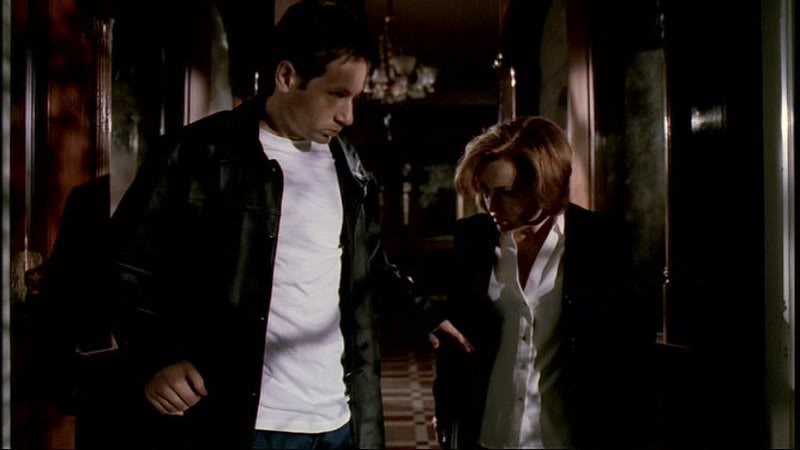
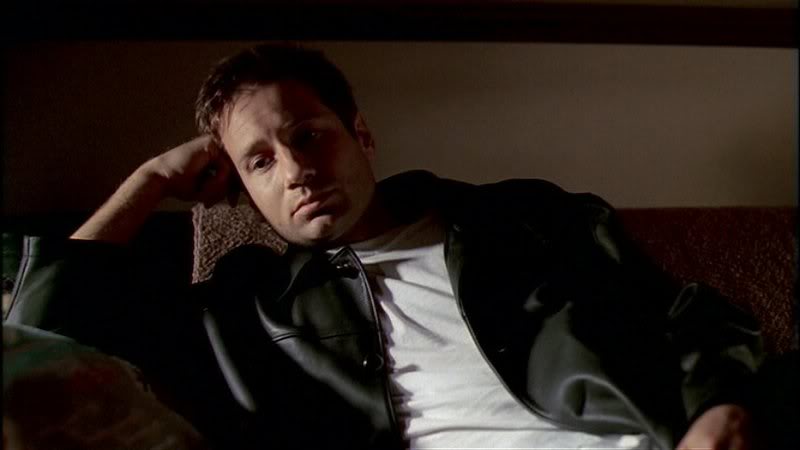
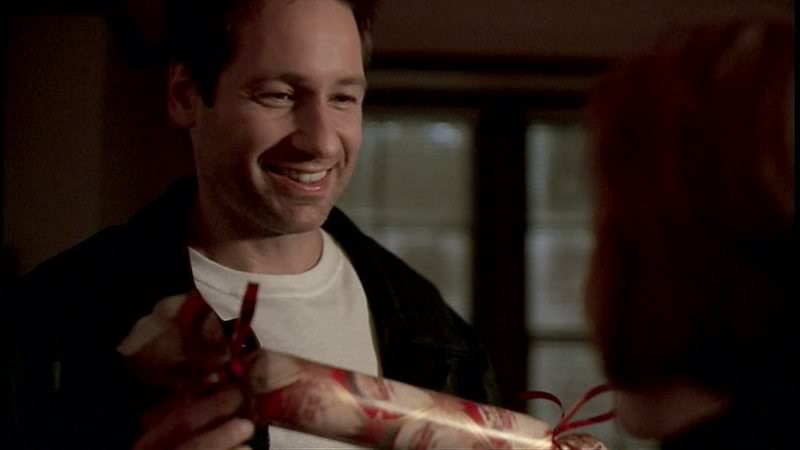
-- It was speculated that the name "J. Cameron & Son -- Kilmarnock" was a reference to director James Cameron and his movie Titanic. I haven't been able to find any indication that was true. But there was a company in Scotland (which is where Kilmarnock is located) called J. Cameron & Sons which made the dials that were used by clockmakers, and often the dialmaker's name appeared on the clockface.
-- In the scene where the very bloody Mulder and Scully are struggling to get to the front door of the house, in the episode as aired Scully asked Mulder if he was afraid, then noted "I am," to which Mulder replied, "I am too." But in the original script, Scully asked Mulder if he was afraid of being alone.
-- In the episode as aired, Mulder was watching a version of the holiday classic A Christmas Carol. However, in the original script, it is noted that Mulder is watching Silent Night, Deadly Night, a horror movie, and a scene with a knife-wielding Santa. The script also noted that "atop the TV is one lone Christmas present, slender and circular, ten inches long. No other signs of Christmas or the season are in evidence."
-- In spite of Carter's script direction, Mulder had a Christmas stocking hanging above his aquarium. I have to admit I saw the episode several times before I noticed this.
-- I'm one of those who were glad we didn't find out what gifts Mulder and Scully gave to each other. I think it was so much nicer to fade out on that private moment between them and leave the gifts chosen to our imaginations.
-- There was an ongoing debate about whether the character of Fox Mulder is Jewish or not. (Duchovny often said he would play Mulder as Jewish until he was told differently.) But in "HTGSC," Mulder hung up a stocking, watched Christmas movies, and gave Christmas gifts, and Scully expected him to find someone to be with, to celebrate Christmas with. However, the ghost Lyda said to Mulder, "It isn't like you're going to be eating any Christmas ham, is it?" which is said in the context of Mulder having a lonely life, not having others to celebrate with, and that Scully was going to shoot him, but could be taken as implying that he was Jewish. The debate continues.
-- The song played at the end of the episode was "Have Yourself a Merry Little Christmas" by Bing Crosby.
-- Gillian Anderson remembered "HTGSC" as a "really fun" episode, and said she particularly enjoyed working with Edward Asner. But she also recalled that the vast amounts of fake blood applied to her solidified quickly -- and uncomfortably -- into a gummy mess.
-- Edward Asner began his television acting career in the late 1950s, appearing as a guest on just about every television show imaginable during the 1960s. In 1970, he was cast as the tough but lovable boss Lou Grant on The Mary Tyler Moore Show. In that show's final episode in 1977, all the show's characters (except the incompetent Ted Baxter) were fired from their jobs at the television station where they worked; and Asner moved the character from a half-hour sitcom to an hour-long drama, Lou Grant. In the show, the character of Lou Grant moved to Los Angeles to become city editor of the L.A. Tribune newspaper.
-- Asner received three Emmy Awards for his portrayal of Lou Grant on The Mary Tyler Moore Show and two more for his work on Lou Grant, thus making him the only actor to receive Emmy Awards for playing the same character in a comedy and a drama. Asner has been nominated for Emmy Awards 15 times and has won seven, more than any other male performer. (The other two Emmys were for his work in acclaimed miniseries -- Rich Man, Poor Man and Roots.)
-- At the age of 77, Asner continues to work steadily in front of and behind the cameras. In addition to a lot of voice work, he has had a recurring role on NBC's Studio 60 on the Sunset Strip, playing Wilson White.
-- Asner's co-star in "HTGSC," Lily Tomlin, is no slouch in the Awards department herself. She's been nominated for Emmy Awards a total of 11 times (for acting, writing, and producing) and has won four -- three for writing and one for producing. She's also won a Grammy (in 1971 for her comedy album "This is a Recording"), two Tony Awards (a special one in 1977 and one for Best Actress in 1986 for her one-woman show), and four American Comedy Awards. And she received an Academy Award nomination in 1976 for her supporting role in Robert Altman's Nashville. She won the Kennedy Center's prestigious Mark Twain Prize for Humor in 2003.
-- Lily Tomlin's zany characters, most notably Ernestine the Telephone Operator and little girl Edith Ann, propelled her to stardom as a cast member of Rowan and Martin's Laugh-In in 1969. From television she moved on to film, with roles in Nashville, Nine to Five, All of Me, Big Business, The Beverly Hillbillies, I Heart Huckabees, and most recently A Prairie Home Companion. She was also a big success on Broadway with her one-woman shows playing to packed theaters. She played the recurring role of Deborah Fiderer on The West Wing from 2002 through the show's final episode in 2006.
-- Tomlin studied acting under Jose Chung himself -- Charles Nelson Reilly -- who introduced her to the works of monologist Ruth Draper, a major inspiration for Tomlin's work.
-- For her work on "HTGSC," production designer Corey Kaplan won an award of excellence from the Society of Motion Picture and Television Art Directors.
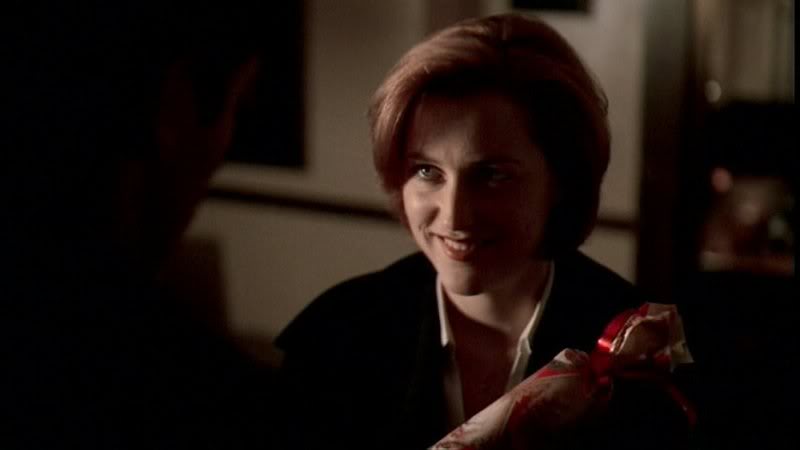

(Thanks to chrisnu and about dd for today's pics.)
Please share your first impressions, favorite (or cringe-worthy) moments, classic lines, favorite fanfic, nagging questions, repeated viewing observations, etc., as today we celebrate "How the Ghosts Stole Christmas."
Have yourself a merry little Christmas,
Polly